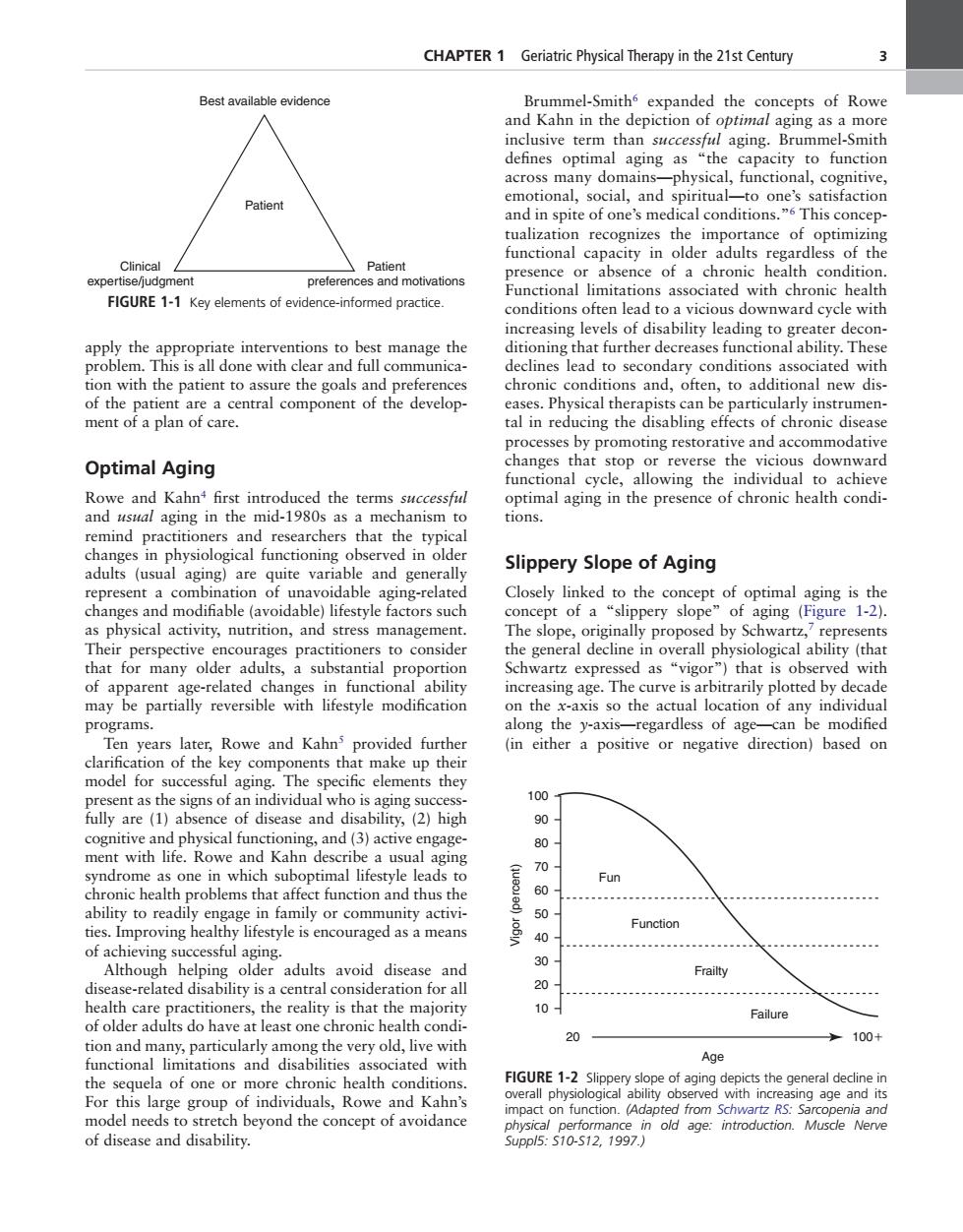正在加载图片...

CHAPTER 1 Geriatric Physical Therapy in the 21st Century Best mel-Smiths anded the oncept of Rowe inclusive term than aging.Brummel-Smith defines optimal aging as "the capacity to function across many domains Patien and on tualization recognizes the impe rtance of timizi functional capacity in older adults regardless of the epenSd presence or absence of a chronic FIGURE 1-1 Key elements of evidence-informed practice. vith ch hea sing lev of disability lea ditioning that further decreases functional ability.Thes communica- declines lead to secondary conditions assoc d wit ns ar to ac new dis tal in reducing the disabling effects of chronic disease processes by promoting restorative and accommodative Optimal Aging changes that stop or reverse the downwar n owing the Rowe and Kahn+first intr aging and usual the pres remind practitioners and researchers that the typical olde Slippery Slope of Aging aging)are quite var mal a style g-re of a of opt as physical activity,nutrition,and stress management resents encourages practitioners to consider er adu sa substantial propor d as that observe wit Th along the v-axis regardless of age can be modified Ten years later,Rowe and Kahns provided further (in either a positive or negative direction)based on s of aging 100 90 80 Fun ability to readily en 50 Function avoid 2 health care practitioners,the reality is that the majorit 10 of older adults do have at least one chronic health condi Failure 100+ Age ctondl associate wit For this large group of individuals.Rowe and Kahn's FIGURE 1-pperspfn depicts model needs to stretch beyond the concept of avoidance of disease and disability. CHAPTER 1 Geriatric Physical Therapy in the 21st Century 3 apply the appropriate interventions to best manage the problem. This is all done with clear and full communication with the patient to assure the goals and preferences of the patient are a central component of the development of a plan of care. Optimal Aging Rowe and Kahn4 first introduced the terms successful and usual aging in the mid-1980s as a mechanism to remind practitioners and researchers that the typical changes in physiological functioning observed in older adults (usual aging) are quite variable and generally represent a combination of unavoidable aging-related changes and modifiable (avoidable) lifestyle factors such as physical activity, nutrition, and stress management. Their perspective encourages practitioners to consider that for many older adults, a substantial proportion of apparent age-related changes in functional ability may be partially reversible with lifestyle modification programs. Ten years later, Rowe and Kahn5 provided further clarification of the key components that make up their model for successful aging. The specific elements they present as the signs of an individual who is aging successfully are (1) absence of disease and disability, (2) high cognitive and physical functioning, and (3) active engagement with life. Rowe and Kahn describe a usual aging syndrome as one in which suboptimal lifestyle leads to chronic health problems that affect function and thus the ability to readily engage in family or community activities. Improving healthy lifestyle is encouraged as a means of achieving successful aging. Although helping older adults avoid disease and disease-related disability is a central consideration for all health care practitioners, the reality is that the majority of older adults do have at least one chronic health condition and many, particularly among the very old, live with functional limitations and disabilities associated with the sequela of one or more chronic health conditions. For this large group of individuals, Rowe and Kahn’s model needs to stretch beyond the concept of avoidance of disease and disability. Brummel-Smith6 expanded the concepts of Rowe and Kahn in the depiction of optimal aging as a more inclusive term than successful aging. Brummel-Smith defines optimal aging as “the capacity to function across many domains—physical, functional, cognitive, emotional, social, and spiritual—to one’s satisfaction and in spite of one’s medical conditions.”6 This conceptualization recognizes the importance of optimizing functional capacity in older adults regardless of the presence or absence of a chronic health condition. Functional limitations associated with chronic health conditions often lead to a vicious downward cycle with increasing levels of disability leading to greater deconditioning that further decreases functional ability. These declines lead to secondary conditions associated with chronic conditions and, often, to additional new diseases. Physical therapists can be particularly instrumental in reducing the disabling effects of chronic disease processes by promoting restorative and accommodative changes that stop or reverse the vicious downward functional cycle, allowing the individual to achieve optimal aging in the presence of chronic health conditions. Slippery Slope of Aging Closely linked to the concept of optimal aging is the concept of a “slippery slope” of aging (Figure 1-2). The slope, originally proposed by Schwartz,7 represents the general decline in overall physiological ability (that Schwartz expressed as “vigor”) that is observed with increasing age. The curve is arbitrarily plotted by decade on the x-axis so the actual location of any individual along the y-axis—regardless of age—can be modified (in either a positive or negative direction) based on Patient Best available evidence Clinical expertise/judgment Patient preferences and motivations FIGURE 1-1 Key elements of evidence-informed practice. 100 90 80 70 60 50 40 30 20 10 20 100 Vigor (percent) Age Fun Function Frailty Failure FIGURE 1-2 Slippery slope of aging depicts the general decline in overall physiological ability observed with increasing age and its impact on function. (Adapted from Schwartz RS: Sarcopenia and physical performance in old age: introduction. Muscle Nerve Suppl5: S10-S12, 1997.)